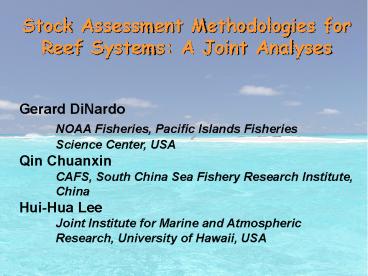Stock Assessment Methodologies for Reef Systems: A Joint Analyses - PowerPoint PPT Presentation
Title:
Stock Assessment Methodologies for Reef Systems: A Joint Analyses
Description:
Stock Assessment Methodologies for Reef Systems: A Joint Analyses Gerard DiNardo NOAA Fisheries, Pacific Islands Fisheries Science Center, USA – PowerPoint PPT presentation
Number of Views:185
Avg rating:3.0/5.0
Title: Stock Assessment Methodologies for Reef Systems: A Joint Analyses
1
Stock Assessment Methodologies for Reef Systems
A Joint Analyses Gerard DiNardo NOAA
Fisheries, Pacific Islands Fisheries Science
Center, USAQin Chuanxin CAFS, South China Sea
Fishery Research Institute, China Hui-Hua
Lee Joint Institute for Marine and Atmospheric
Research, University of Hawaii, USA
2
Goal
- Capacity Building via Staff Exchange
- Dr. Qin to PIFSC for 30 days to learn about reef
stock assessments - Time permitting, conduct preliminary stock
assessments of key species in the Guangdong
Province based on available data - But
- Data sets are large and not easily accessible
(still raw) - Habitat and stock enhancement occurring
- Have to understand the extent and associated
benefits of enhancement programs before
conducting any assessment
3
Work Plan
- Day 1-15
- Data screening, rectification and mining
- Spatiotemporal views of the data
- Exploratory analyses and literature search
- Day 16-30
- Identify analytical strategy (right tool for the
job) - Conduct preliminary analyses
- Initiate development of an Assessment strategy
allowing for ecossystem enhancements
4
Stock Assessment Process
Catch Logbooks, Observers, Age/Size Data
Abundance Resource Survey, Fishery CPUE, Age/Size
Data
Biology Age, Growth, Maturity
Advanced Model Habitat, Climate, Ecosystem
Population Model
Stock Status
5
Conceptual population assessment model for the
annual change in biomass (B) of a harvested LMR
- Biomass additions in year T due to
- Somatic growth (G)
- Recruitment (R)
- Biomass losses in year T due to
- Fishery yield (Y)
- Natural deaths (D)
Adapted from Russell (1931. Some theoretical
considerations on the Overfishing problem.
Journal du Conseil, 61-20)
6
Equilibrium, Sustainability, and Maximization
- An equilibrium stock size has an associated
sustainable equilibrium yield - Maximum sustainable yield (MSY) generally occurs
at an intermediate stock size and depends on the
harvest pattern - MSY is the largest average yield that can
continuously be taken from a stock under existing
environmental conditions Ricker
Catch gt Equilibrium Reduces Biomass
Maximum Sustainable Yield (MSY)
CATCH
Equilibrium Yield Curve
Catch lt Equilibrium Allows Growth
K
STOCK BIOMASS
7
Biological Reference Points
- Reference points measure the status of a fish
stock to provide rational guidance for management - Limit reference points express the maximum degree
of safe exploitation - Target reference points express the degree of
exploitation desire by management - MSY is the limit for USA marine fisheries and
optimum yield is the target - The target optimum yield is MSY as reduced by
any relevant economic, social, or ecological
factor - Sustainable Fisheries Act
(2008)
8
Effects of an Environmental Shift
Favorable Environment
MSY
Unfavorable Environment
Conceptual model for artificial reef enhancement
Substitute habitat for environment
9
Incorporating Environmental Signals into
Forecasts of Future Recruitment and Catch
10
Requirements for Advancing Assessment(Data
Needs)
- Catch Monitoring
- CPUE Time Series
- Size Structure
- Movement (connectivity)
- Stocking numbers
- Explore utility of size-based assessment approach
(life history information and length data)
PIFSC-SEFSC-UM Joint Collaboration
11
Thank You































